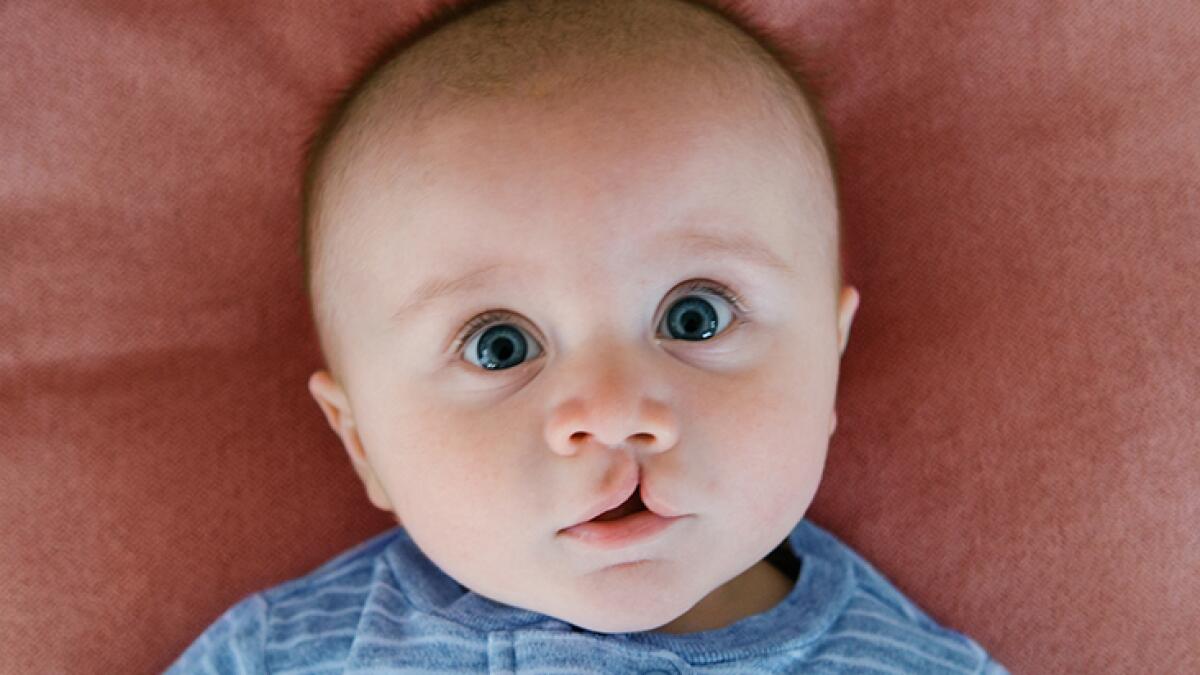
Key facts
- A cleft lip or palate happens when parts of your lip, upper jaw or the roof of your mouth don’t join properly during development in the womb.
- A cleft lip or palate can lead to problems with breast or bottle feeding, and later with speech.
- Surgery can resolve these issues as well as help the child’s appearance and speech to develop normally.
What is cleft lip or palate?
Cleft lip or palate develops when parts of the lip, upper jaw or roof of the mouth don’t join properly in early pregnancy, resulting in a ‘cleft’ or opening. While this condition is congenital (present at birth), there is a range of treatments available for babies who are born with it.
About one baby in every 800 in Australia is born with a cleft lip or palate.
What are the types of cleft lip or palate?
The type of condition depends on which parts don’t join together.
Cleft lip: The upper lip is made up of two large parts at each side and a small part in the middle. A cleft happens if one or more of these three parts fails to join together when the fetus is 7 to 9 weeks old. Sometimes a cleft lip can be just a small notch in the gum.
Cleft palate: The roof of the mouth forms when bones and soft tissues move from the sides of the mouth and join in the middle. If this fails to happen when the fetus is 10 to 12 weeks old, there will be a gap in the roof. This can just be in the soft tissue at the back of the mouth or may extend all the way forward to the gum.
Cleft lip and cleft palate: When the upper lip, gum and roof of the mouth fail to join together when the fetus is 12 weeks old, there will be a cleft. This can be on one side only (unilateral) or on both sides (bilateral). The gap is between the mouth cavity and the nasal cavity.

What are the symptoms of cleft lip or palate?
A cleft lip or palate can lead to significant problems with feeding since the baby will find it hard to suck. Later, babies may also experience problems with their speech and hearing, ear infections, dental decay and jaw development. Children and adults who were born with cleft palate may also have a nasal speaking voice.
How is cleft lip or palate diagnosed?
Cleft lip or palate are usually noticed as soon as the baby is born and will start to be managed right away.
The condition is often picked up during an ultrasound at about 18 weeks of pregnancy. If cleft lip or palate is suspected, the doctor may recommend an amniocentesis, where the amniotic fluid is tested to check for other birth defects.
If you are pregnant and this happens to you, you should discuss with your doctor both the benefits and the risks of having amniocentesis.
How is cleft lip or palate treated?
When a baby is born with cleft lip or palate, the first priority is arranging how to feed them. It can be extremely difficult for the baby to breastfeed, and they usually need to be fed with a bottle and special nipple. In some cases, the baby will at first need a tube through their nose into their stomach to help with feeding. A midwife who is trained in cleft lip or palate will advise on how to feed the baby.
Surgery to repair a cleft lip is normally done when the baby is between 3 and 6 months. Surgery to repair a cleft palate is done between 9 and 18 months. The type of operation depends on how the lip and palate have formed. The surgery is done in hospital by a specialist plastic surgeon. Two or 3 different operations might be needed.
As they grow older, children with cleft lip or palate need to be monitored closely for hearing or speech difficulties. This is because they can have problems with their middle ear. They will also need to see a dentist and possibly an orthodontist for specialised dental treatment.
Cleft lip and palate repair usually leaves a visible scar and noticeable differences in the nose, gums and teeth. For some people, this visible difference can cause problems with self-esteem because of how they believe others perceive them. Others cope well with these differences.
When to seek help
Babies with cleft lip or palate will need help from a team of specialists in the cleft clinic (usually located at your nearest state children’s hospital). A cleft coordinator will guide you. Some of the specialists you might see include:
- cleft coordinator
- speech pathologist
- paediatrician
- lactation consultant
- dietitian
- audiologist
- ear, nose and throat (ENT) surgeon
- dentist
- orthodontist
Your child should be seen regularly by a cleft clinic, usually at 18-24 months, then at 3, 5, 8, 12 and 16-18 years old.


